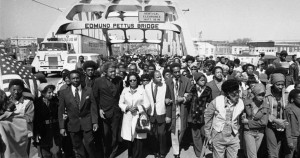 The Civil Rights Movement (1954-1968)
The Civil Rights Movement (1954-1968)
Intro: Overview, Attendance, Agenda, Introduce Essential Question, Objectives, Standards
Enduring Understanding: The struggle for individual rights and equality often shapes a society’s politics.
Essential Questions: Why do you think the civil rights movement made gains in postwar America? What motivates a society to make changes?
Objectives:
—know the reasons for nonviolent passive resistance and how it helped to challenge segregation and racism.
—why the Civil Rights Act of 1964 and the Voting Rights Act of 1965 were considered turning points in the civil rights movement.
—that even though political gains were achieved during this time, many African Americans still faced economic inequality.
Standards:
…Time, Continuity and Change (#7)
…People, Places and Environments (#7)
…Individuals, Groups and Institutions (#2, 3, 4, 7, 8)
…Power, Authority and Governance (#1, 2, 5)
…Civic Ideals and Practices (#1)
Selma
—Small and Whole Class Discussion
Picturing Freedom Group Activity
—Back in the 1960ʻs, how would you picture freedom?
